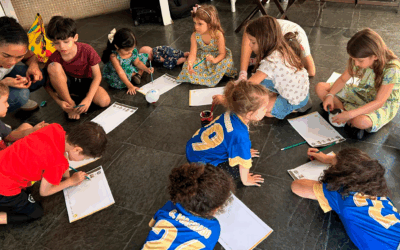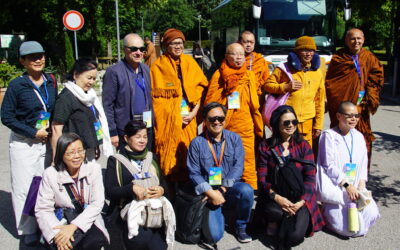 An emblematic aspect of the Focolare Movement is communion, unity. This is the consequence of living the Word and sharing its effects. Chiara wrote: ‘There was a time when the Movement didn’t exist and then it did. We know what made it be born was the Holy Spirit, which worked in a very precise way. He put the first focolarine in an attitude of being able to take on, in a big way, I would say in a unique manner, the Gospel; He enlightened them through its Words and gave them the push to live them. ‘What was the effect? We know, unthinkable and marvellous: due to the Word lived radically, the Word taken seriously, a big community was quickly born, and spread rapidly throughout more than one hundred villages in the Trentino region: it was the Focolare Movement. These people used to ignore one another and then became family; Christians, previously indifferent to one another, became connected into one. Therefore the Word of God makes this miracle, can make this miracle: give life to a visible community’. “Unity” is the word which most distinguishes the Focolare Movement. Unity which is both communion and communication. Unity needs constant communication to keep up to date. The means of communication are also useful for unity. The 38 editions of the magazine ‘Citta Nuova’ which is published in 24 languages, together with other journals such as Gen’s – for those in priesthood, Unita e Carismi – for those in religious life, are helping to reach unity. As are the audiovisual productions made by the ‘Chiara Lubich Centres’. In 2000, Chiara Lubich addressed an assembly of communicators and offered them 4 ‘principles’ of communication: The first thought: ‘Communication is essential. The effort to live the Gospel in everyday life, the experience of the Word of Life, has always been indissolubly united with communicating it, describing the various steps and the results, since it is a law that we love others as ourselves. We believe that what is not communicated is lost. So life generates light, both for those speak and for those who listen, and it seems the experience is fixed in eternity. They have almost a vocation for communication. The second thought: ‘To communicate, we feel the need “to make ourselves one” as we say, with the one who is listening. So when we speak or address some topic, we do not stop at merely relating the content of our thoughts. First we feel the need to know we have before us, to know the listener or the audience, their needs, desires, problems. Likewise, we make ourselves known as well, explaining why we want to give this talk, what has led us to do it, its effects on ourselves, thereby creating a certain mutuality. In this way the message is received not only intellectually but is also shared in and taken to heart by all. A third thought: ‘Emphasize the positive. It has always been our way to put what is good into light, out of a conviction that it is infinitely more constructive to point out what is good, dwelling on the good and positive aspects, than to stop at the negative, even though whoever is in a position of responsibility has the duty at the proper moment to point out errors, shortcomings and failures. Finally: the person matters, not the media, which are merely an instrument. Bringing about unity first of all requires the indispensable means, which is the person, St. Paul’s new self, who has welcomed the mandate of Christ to be leaven, salt, light of the world.’
An emblematic aspect of the Focolare Movement is communion, unity. This is the consequence of living the Word and sharing its effects. Chiara wrote: ‘There was a time when the Movement didn’t exist and then it did. We know what made it be born was the Holy Spirit, which worked in a very precise way. He put the first focolarine in an attitude of being able to take on, in a big way, I would say in a unique manner, the Gospel; He enlightened them through its Words and gave them the push to live them. ‘What was the effect? We know, unthinkable and marvellous: due to the Word lived radically, the Word taken seriously, a big community was quickly born, and spread rapidly throughout more than one hundred villages in the Trentino region: it was the Focolare Movement. These people used to ignore one another and then became family; Christians, previously indifferent to one another, became connected into one. Therefore the Word of God makes this miracle, can make this miracle: give life to a visible community’. “Unity” is the word which most distinguishes the Focolare Movement. Unity which is both communion and communication. Unity needs constant communication to keep up to date. The means of communication are also useful for unity. The 38 editions of the magazine ‘Citta Nuova’ which is published in 24 languages, together with other journals such as Gen’s – for those in priesthood, Unita e Carismi – for those in religious life, are helping to reach unity. As are the audiovisual productions made by the ‘Chiara Lubich Centres’. In 2000, Chiara Lubich addressed an assembly of communicators and offered them 4 ‘principles’ of communication: The first thought: ‘Communication is essential. The effort to live the Gospel in everyday life, the experience of the Word of Life, has always been indissolubly united with communicating it, describing the various steps and the results, since it is a law that we love others as ourselves. We believe that what is not communicated is lost. So life generates light, both for those speak and for those who listen, and it seems the experience is fixed in eternity. They have almost a vocation for communication. The second thought: ‘To communicate, we feel the need “to make ourselves one” as we say, with the one who is listening. So when we speak or address some topic, we do not stop at merely relating the content of our thoughts. First we feel the need to know we have before us, to know the listener or the audience, their needs, desires, problems. Likewise, we make ourselves known as well, explaining why we want to give this talk, what has led us to do it, its effects on ourselves, thereby creating a certain mutuality. In this way the message is received not only intellectually but is also shared in and taken to heart by all. A third thought: ‘Emphasize the positive. It has always been our way to put what is good into light, out of a conviction that it is infinitely more constructive to point out what is good, dwelling on the good and positive aspects, than to stop at the negative, even though whoever is in a position of responsibility has the duty at the proper moment to point out errors, shortcomings and failures. Finally: the person matters, not the media, which are merely an instrument. Bringing about unity first of all requires the indispensable means, which is the person, St. Paul’s new self, who has welcomed the mandate of Christ to be leaven, salt, light of the world.’
Initiative and hard work!
Initiative and hard work!




0 Comments